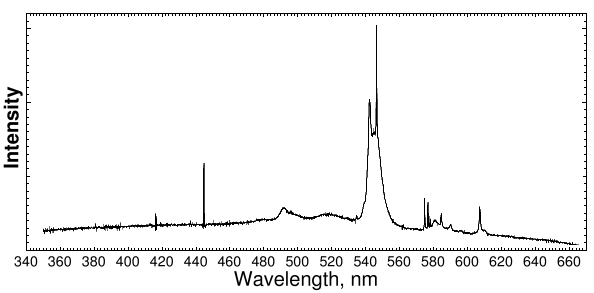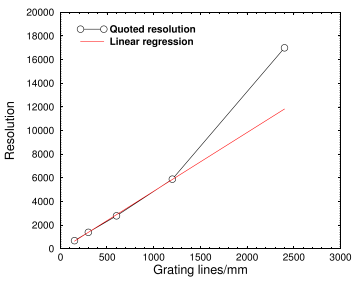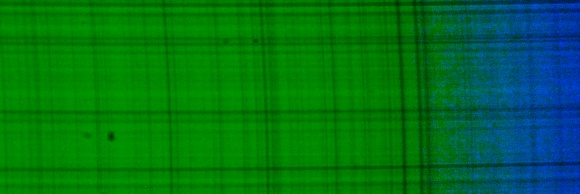Introduction
In Part 1 I gave an overview of the design of our high-resolution spectrograph. Part 2 was an overview of the construction. In this section I describe some testing results and test spectra. Testing has not yet been completed. More results will be added in the future.
Resolution
The theoretical resolving power of a grating is R = L / λ = N m, where L is the path difference imposed by the grating, N is the total number of rulings, and m is the order (=1). Thus a 25.4 mm wide grating with 600 lines per millimeter has a theoretical resolution of 600 × 25.4 = 15,240, and an 1800 l/mm grating has a theoretical resolution of 1800 × 25.4 = 45,720.
Measured resolution is given by λ / Δλ. With a 600 l/mm grating blazed at 500 nm, the 546.5 nm line from a compact fluorescent bulb had a FWHM of 3 pixels on the D90 sensor, for a resolution of 2513. This is about 50% higher than I could get with an earlier design with the same grating using lenses instead of mirrors. With a 2400 l/mm grating, the resolution should be 4× higher, or about 10,000. We shall see.
 Spectrum of compact fluorescent bulb (2 watt, 5100K). Unlike spectra
from regular fluorescents, the 365 nm mercury line is not detectable.
Spectrum of compact fluorescent bulb (2 watt, 5100K). Unlike spectra
from regular fluorescents, the 365 nm mercury line is not detectable.
Comparison with other designs
The resolution achieved here is only about 1/4 of that reported by Schieffer after correcting for the different grating rulings. This is partly because their instrument had 4×4" square mirrors of 1 meter focal length, which they made by cutting up a 8-inch parabolic mirror. But the main reason is that their grating (50 × 100 mm) was four times as large as ours. This factor is sufficient to account for our 4× lower resolution, and confirms the validity of the parabolic mirror approach.
The highest-resolution spectrograph marketed at amateur astronomers is the Shelyak Lhires III. This is a Littrow design advertised as having a resolution of 17,000 when using a 2400 l/mm grating. The graph below shows their published specs.
 Quoted resolution vs. grating type in Lhires III spectrograph.
Quoted resolution vs. grating type in Lhires III spectrograph.
The resolution of our spectrograph at 600 l/mm is comparable to the Shelyak Lhires III, maybe a little lower. But there is something strange here. Resolution should be strictly proportional to the total number of lines. However, their 2400 line/mm grating gives much higher resolution than expected. The only way this could happen is if their 2400 l/mm grating is larger than the other gratings. This would require different optics to fill the grating, which seems unlikely from the diagrams on their website.
This number (17,000) is quoted in two books on the subject. The equations say the resolution should be closer to 11,000. I would be interested in hearing from owners of this instrument about what is going on here. It looks like an error to me.
Update, June 21 2021 One user reports that the 2400 l/mm grating is indeed bigger, 50×25 mm. This would explain the results. In spectroscopy, bigger is better.
Spectra
 Portion of spectrum of sunlight in green region. Vertical lines are absorption bands.
Horizontral lines are caused by dust partially blocking the slit. About 98 absorption
bands are visible. Image was cropped and resized to half original width. Shorter
wavelengths are to the right.
Portion of spectrum of sunlight in green region. Vertical lines are absorption bands.
Horizontral lines are caused by dust partially blocking the slit. About 98 absorption
bands are visible. Image was cropped and resized to half original width. Shorter
wavelengths are to the right.
